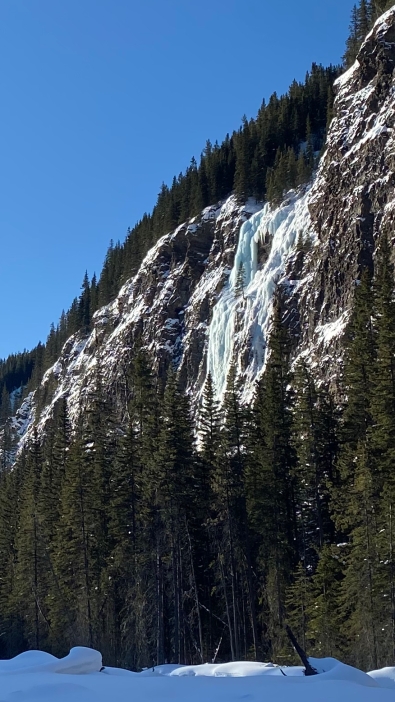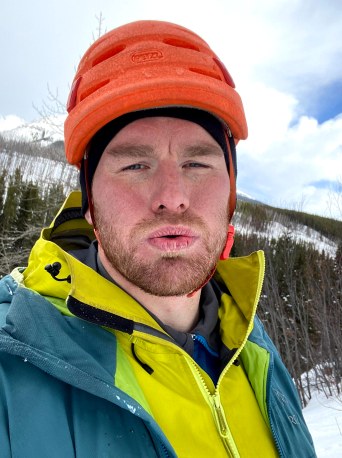I’m sitting on a sparsely filled plane, amongst passengers sporting various forms of infection control paraphernalia. The atmosphere is subdued; every throat clearance or cough is met with a sea of side eye from suspicious neighbours. It has been a slightly odd trip to the Canadian Rockies in pursuit of frozen water to climb. Each night we returned from another cold adventure to warmth and food and safety, to read and discuss the increasingly worrying news of the day.
At times it has seemed extremely hedonistic to have flown across the world in this climate to pursue a minor sporting goal, and at others seems like the perfect antidote to the situation. As Will and I discuss how our future plans could be impacted by the trajectory of the novel corona-virus we are settled by the understanding that what we pursue in these mountains are available to us anywhere, perhaps even in quarantine. Mastery, autonomy and purpose.
Mastery is the skills and experience we require, autonomy is the personal responsibility we undertake, and purpose is a defined goal which feels worthy even if it is actually arbitrary.
The final climb of the trip was a Rockies classic, Moonlight (WI4), which tested all three of the aforementioned. We first spied Moonlight rising above the pine trees on the flank of a creek bed in Evan Thomas provincial park in the Kananaskis, Alberta. Will and I both reacted with a sharp intake of breath and the same exhaled expletive. Long and steep and glistening in the sunlight, this waterfall was clearly going to pose a challenge requiring all of our available mastery and asking us to commit completely to the purpose.

We made tracks through the snow to reach the base of the icefall, readied our equipment, discussed our tactics and had a bite to eat. Our vehicle informed us it was -14c at the trailhead, and it didn’t feel a lot warmer looking up, although we were now steaming from the exertion of the approach. Without much ceremony Will started up the first pitch, methodically working his way up the first section as it grew increasingly steep. The ice on this section was hard, smooth and brittle, although happily with plenty of existing steps from previous ascents. Initially this made for moderate climbing, but as the angle increased, the lack of ‘bite’ into the hard ice became slightly more worrying. We may not have been entirely diligent in the daily ritual of ice tool sharpening, and our ice screws had seen better days. Will built a hanging belay on the right hand side after approximately 45m at the site of a pair of in-situ Ablakov threads.
After allowing my hands to warm up and swapping gear, I started up the second pitch which we had judged to be the crux. The pitch started fairly moderately but soon became steeper, and unlike the lower section of the ice, had few pre-existing steps or ice tool placements. The ice was still hard, but had obviously changed form since the last ascent of the right hand side. This ice appeared to be formed of a build up of drips frozen in place as they ran over underlying ice, leading to very textured and fragile layers of ice. This meant that every move on the steeper angled ice became more strenuous- requiring multiple hits of an ice tool to land a solid placement. Repeated kicks of the crampons searching for security dug deeper and deeper into the ice creating an overhang and taking less and less of my body weight.

One of the ongoing issues to deal with when ice climbing is that once some upward progress has been made, you are further from your protection- facing a larger and larger fall should you get too ‘pumped’ to hold on (ie forearms too fatigued). Panic and nervousness can compound this by making you over grip, hastening the onset of fatigue. You can counter this by placing ice screws as protection at reasonable intervals- on placing protection you can generally relax a little and recover. The conundrum comes however, when on a steep section. On steeper terrain your feet are able to take less than 100% of your body weight, and so to drill a screw into the ice with one arm, you need to hang on with the other which is a tiring endeavour. The steeper the ice becomes, the more weight on that arm. When getting pumped climbing high above your last piece of protection, do you press on to the next resting position above you, risking a larger fall, or risk hanging around in a fatiguing position to place a screw? If you fail to place the screw before getting totally fatigued you will fall, and even if you succeed you will need to continue climbing with that accumulated pump through to the next resting position.
There were a couple of sections on which I climbed up from a relatively restful position, got pumped, started to panic, and then reversed, unsure how best to proceed. Reversing back to a rest is a tactic I sometimes use when rock climbing if I don’t know which line to take during what I consider to be a ‘no fall zone’- where taking a fall is not really an option due to some hazard. Just being attached to a rope doesn’t guarantee safety. Perhaps it is overblown, but the general recommendation for ice climbing is ‘never fall when leading’: you have several kilos of pointy things attached to your limbs after all. Being belayed from a hanging stance, unfortunately situated directly below the line I was climbing, added to my strong desire not to fall off during this pitch. Down climbing on ice is unfortunately much harder than on rock- ice tool placements can’t really be made from above since they generally rely on downward swing. Nevertheless after just over an hour I clipped a carabiner into the belay at the flat step above the second pitch and shouted ‘safe’ down to Will. Will followed up the pitch in short order, before dispatching the top 30m of much wetter ice with little trouble.

This pitch of climbing was probably the most consistently pumped I have been during a climb, a constant battle to manage the level of fatigue. It was a completely absorbing experience requiring constant focus on making small steps upward and avoiding mistakes. Normal senses- hunger, thirst, cold, worry and even fear fade completely in this endeavour.
Sitting on this plane reflecting, it is clear that life is about to change. As our plans and routines are disrupted by isolation, postponements and cancellations, let’s try and remember the values we seek rather than the specific experiences. Due to the travel restrictions I may not be able to return to the mountains of Canada soon, but I can still hold the same values. I can develop mastery though training at home and apply to other areas of my life. I can express autonomy and purpose by taking personal responsibility to minimise my contribution to the spread of virus in society, and stay optimistic about a return to freedom of movement for everyone and a return to economic prosperity.

This is a brilliant piece. I felt transported to the ice dealing, with all those emotions. A great message, encouraging positive thinking and action for the future and a new kind of challenge.
LikeLike